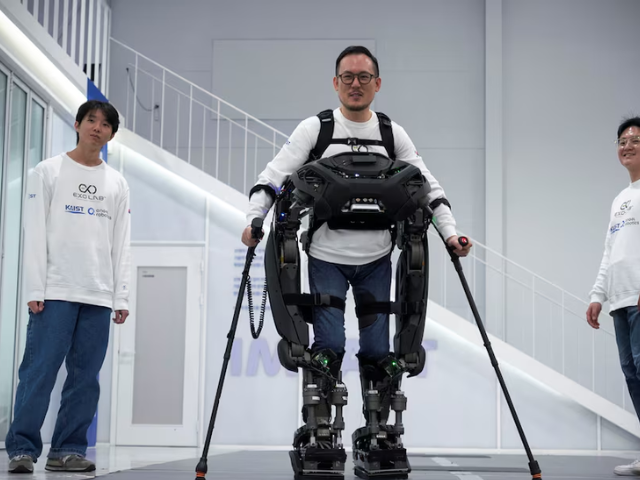Researchers at the Korea Advanced Institute of Science and Technology (KAIST) have developed an innovative wearable robot designed to assist paraplegic individuals in walking, maneuvering obstacles, and climbing stairs.
The robot, named WalkON Suit F1, is a lightweight exoskeleton that integrates advanced robotics to enhance mobility for those with lower-body paralysis.
The WalkON Suit F1 was demonstrated by Kim Seung-hwan, a paraplegic team member and part of KAIST’s Exoskeleton Laboratory.
The prototype allowed Kim to walk at a speed of 3.2 kilometers per hour, climb stairs, and step sideways to sit on a bench.
“It can approach me wherever I am, even when I’m sitting in a wheelchair, and be worn to help me stand up, which is one of its most distinct features,” Kim explained.
The exoskeleton weighs 50 kilograms and is made from aluminum and titanium. It features 12 electronic motors that replicate human joint movements and is equipped with sensors in the soles and upper body that collect 1,000 signals per second, ensuring balance and anticipating the user’s intended actions.

Photo: Reuters
Front-facing lenses function as eyes, analyzing the environment, detecting obstacles, and determining stair heights to compensate for users’ lack of sensory feedback.

Photo: Reuters
The development was partly inspired by the superhero film Iron Man. Team member Park Jeong-su said, “After watching Iron Man, I thought it would be great if I can help people with a robot in real life.”
Kim’s use of the WalkON Suit F1 earned him the gold medal in the exoskeleton category at Cybathlon 2024, an event showcasing assistive robot technologies for individuals with disabilities. Reflecting on his experience, Kim shared, “I wanted to tell my son that I also used to be able to walk. I wanted to share a diverse range of experiences with him.”
The KAIST team’s invention marks a significant step forward in assistive technology, offering new possibilities for mobility and independence for people with paraplegia.